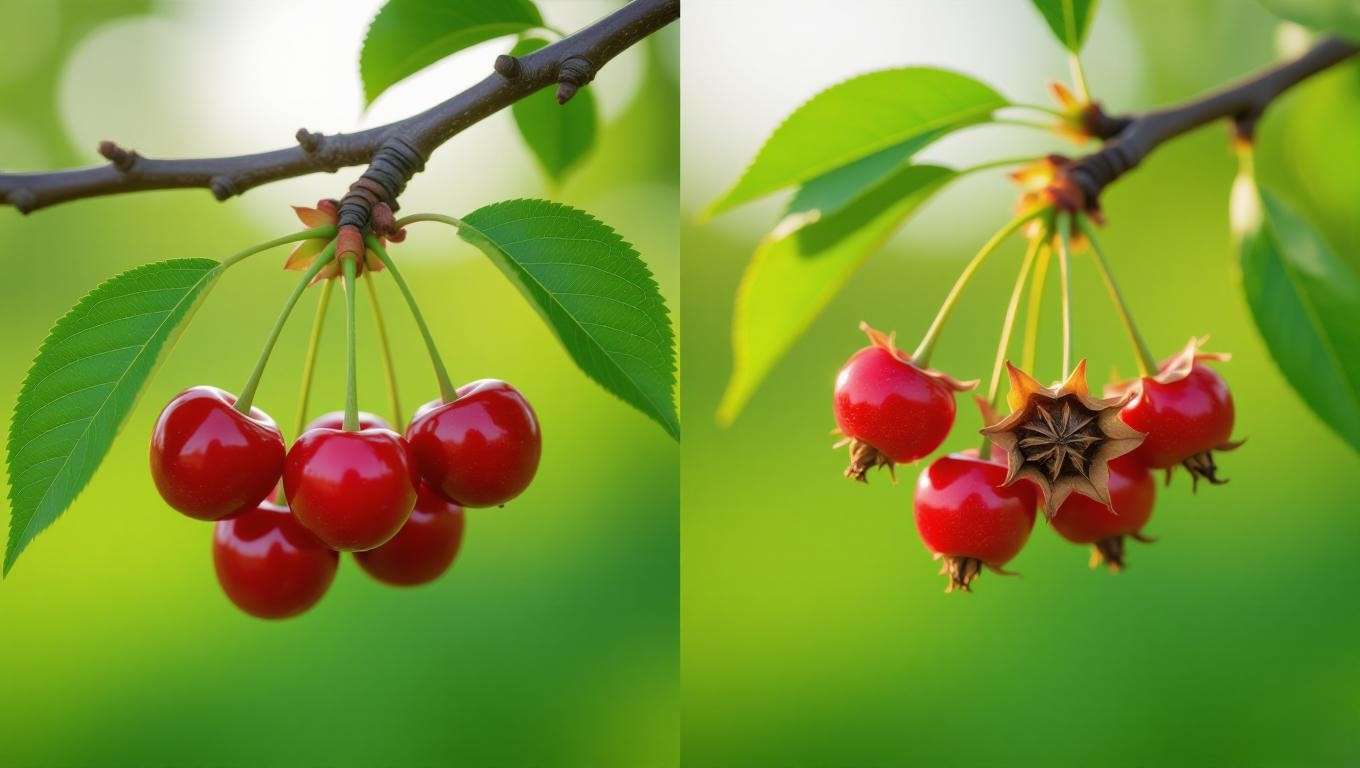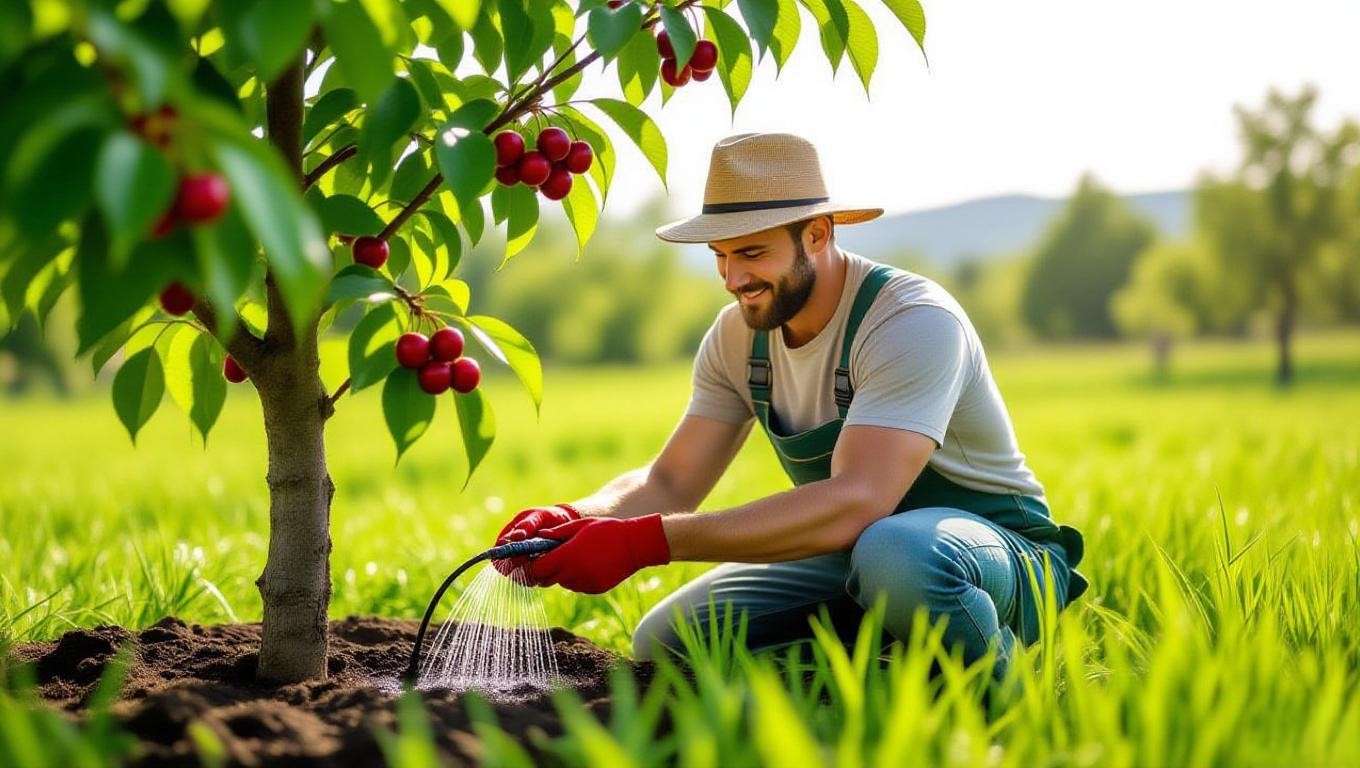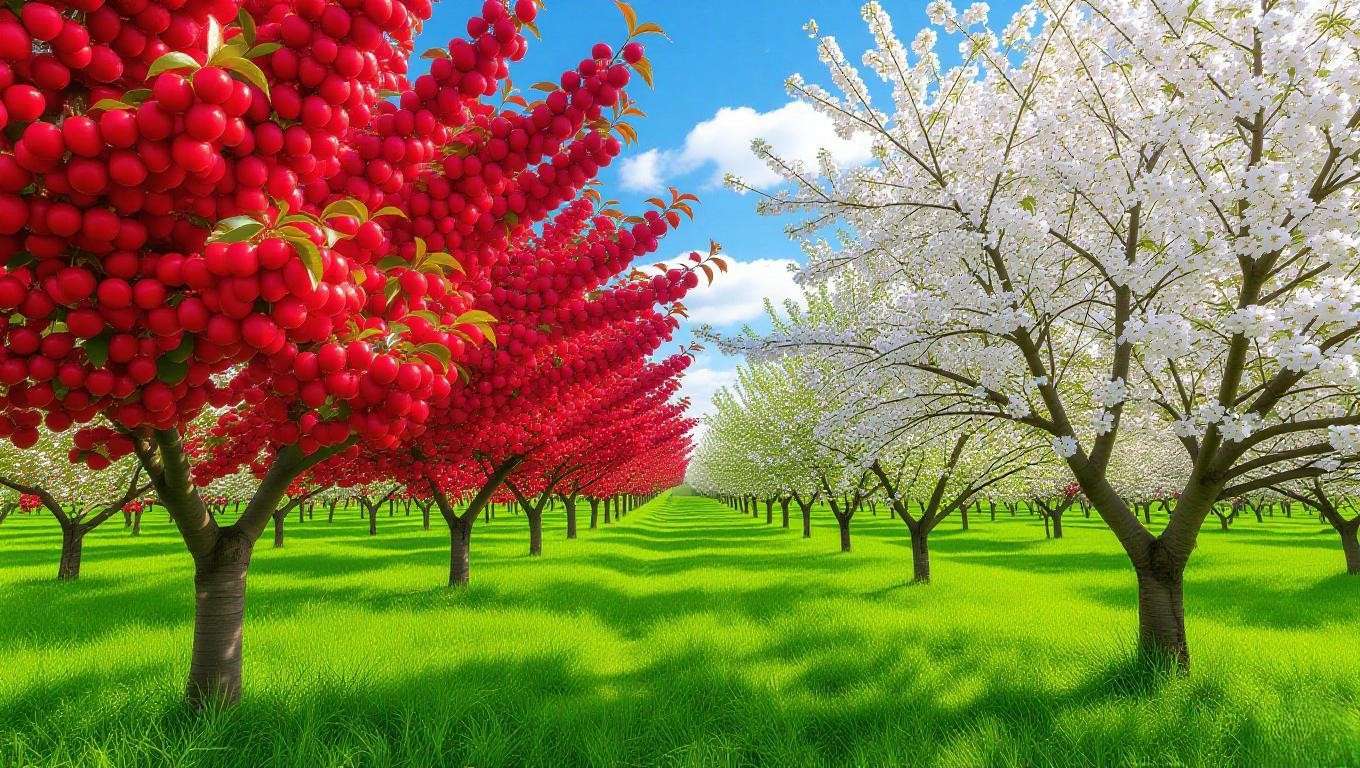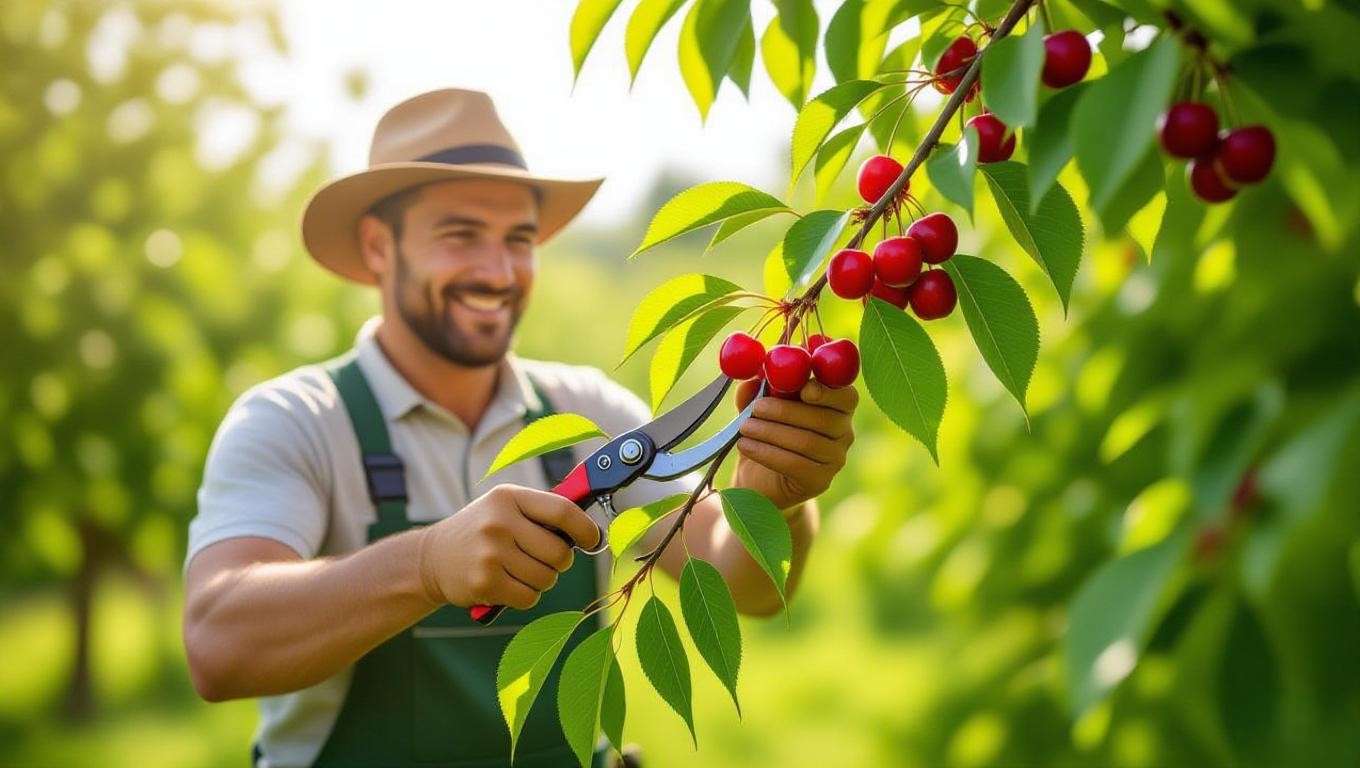Picture this: you’ve nurtured your cherry tree all spring, eagerly awaiting a bountiful harvest of juicy, red cherries. But as summer arrives, your excitement turns to heartache—your cherries are shriveling and dying before they ripen. 😢 If you’re wondering how to deal with cherry tree fruit shriveling and dying, you’re not alone. This common issue frustrates gardeners and orchard owners alike, but the good news is that it’s often fixable with the right knowledge and care. In this comprehensive guide, we’ll uncover why your cherry fruits are struggling and share expert-backed, actionable solutions to restore your tree’s health and secure a thriving harvest. Drawing on decades of horticultural expertise and insights from agricultural research, this article will empower you to diagnose, treat, and prevent fruit loss, ensuring your cherry tree flourishes for years to come. Let’s dive in! 🧑🌾
Understanding Why Cherry Tree Fruits Shrivel and Die 🍒
To save your cherry crop, you first need to understand what’s causing the problem. Fruit shriveling and dying can stem from multiple factors, each requiring a specific approach. By pinpointing the root cause, you can take targeted action to revive your tree and its fruit. Let’s explore the most common culprits.
Common Causes of Fruit Shriveling and Dying 🕵️♀️
Environmental Stress
Cherry trees are sensitive to their environment. Drought, excessive heat, or poor soil conditions can disrupt fruit development. For instance, insufficient water leads to water stress, causing fruits to shrivel as the tree prioritizes survival over fruit production. Similarly, temperatures above 90°F (32°C) can impair fruit set, while poor drainage in heavy clay soils can suffocate roots, leading to fruit drop.
Pests and Diseases
Pests like the cherry fruit fly (Rhagoletis cingulata) lay eggs in developing fruit, causing larvae to feed inside, resulting in shriveled or rotten cherries. Diseases such as brown rot (Monilinia fructicola) or anthracnose (Colletotrichum spp.) can also devastate crops, leaving fruits brown, mushy, or shriveled. These issues are often exacerbated by wet, humid conditions.
Nutritional Deficiencies
Cherries need a balanced supply of nutrients, particularly potassium and calcium, to develop plump, healthy fruits. A lack of potassium can cause small, underdeveloped cherries, while calcium deficiencies weaken cell walls, leading to fruit collapse. Soil imbalances, such as low pH, can lock out these nutrients, starving the tree.
Improper Care Practices
Over-pruning, incorrect watering, or poor pollination practices can sabotage your harvest. For example, excessive pruning in late summer can stress the tree, while inadequate pollination—common in varieties like ‘Bing’ that require cross-pollination—results in poor fruit set and early drop.
The Science Behind Fruit Development 🌱
Cherry fruit development occurs in three key stages: bloom, fruit set, and ripening. During bloom, flowers form and require pollination to develop into fruit. At the fruit set stage, tiny cherries begin to grow, relying on consistent water and nutrients. During ripening, sugars accumulate, and fruits reach their full size. Disruptions at any stage—such as water stress, pest damage, or nutrient shortages—can halt cell turgor pressure (the force that keeps fruit cells plump) or impair nutrient transport, leading to shriveling or premature fruit death. Understanding this process helps you target interventions effectively.
Diagnosing the Problem 🔍
Accurate diagnosis is the first step to saving your cherry tree. By examining your tree and its environment, you can identify the cause of fruit shriveling and dying and choose the best course of action.
Visual Symptoms to Look For 👀
Shriveled cherries often have wrinkled, leathery skin and are smaller than healthy fruits. Dying fruits may turn brown, mushy, or drop prematurely. Compare your tree’s fruit to the following:

| Characteristic | Healthy Cherries | Unhealthy Cherries |
|---|---|---|
| Size | Plump, full-sized | Small, underdeveloped |
| Skin | Smooth, glossy | Wrinkled, dull |
| Color | Vibrant red or dark | Brown, black, or faded |
| Texture | Firm, juicy | Soft, mushy, or dry |
Other signs to check include yellowing leaves (indicating nutrient issues), sticky residue (a sign of pests like aphids), or fungal growth on fruit or branches.
Conducting a Tree Health Check 🌳
Follow these steps to assess your cherry tree’s health:
- Inspect Leaves and Branches: Look for wilting, yellowing, or spotted leaves, which may indicate disease or nutrient deficiencies. Check for dead or discolored bark.
- Examine Roots and Soil: Dig gently near the root zone to check for soggy or dry soil. Use a soil moisture meter (available for $10–$20 at garden centers) to ensure proper hydration.
- Test Soil pH: Cherry trees thrive in slightly acidic soil (pH 6.0–6.8). Use a pH tester to confirm, as extreme pH can lock out nutrients.
- Check for Pests: Look for tiny holes in fruit (cherry fruit fly) or webbing (spider mites).
When to Consult an Expert 🧑🔬
If symptoms persist or you’re unsure of the cause, contact your local agricultural extension service (e.g., through the USDA or universities like Cornell or UC Davis). Certified arborists can also provide on-site diagnostics. For region-specific advice, check resources like the University of California’s Integrated Pest Management Program or the Royal Horticultural Society.
Proven Solutions to Save Your Cherry Crop 🌟
Once you’ve identified the cause, it’s time to act. These expert-recommended solutions address environmental stress, pests, diseases, nutrient deficiencies, and care mistakes to revive your cherry tree and its fruit.

Addressing Environmental Stress 💧
Watering Techniques
Cherry trees need consistent moisture, especially during fruit set and ripening. Water deeply 1–2 times per week, providing 1–2 inches of water (about 10 gallons for a mature tree). Use a soaker hose or drip irrigation to deliver water directly to the root zone. Apply 2–3 inches of organic mulch (e.g., wood chips or bark) around the tree’s base to retain moisture and regulate soil temperature. Avoid overhead watering, which can promote fungal diseases.
Temperature Management
In hot climates, protect trees from heat stress with shade cloths during peak summer temperatures. In windy areas, install windbreaks like hedges or fences to reduce fruit damage. Ensure trees are planted in well-draining soil to prevent root rot in wet conditions.
Managing Pests and Diseases 🐞
Organic Solutions
For cherry fruit flies, use sticky traps or kaolin clay sprays to deter egg-laying. Neem oil or insecticidal soap can control aphids and spider mites. Introduce beneficial insects like ladybugs to naturally reduce pest populations. For brown rot, remove affected fruit and apply organic fungicides like sulfur-based sprays during bloom.
Chemical Options
If organic methods aren’t enough, use EPA-approved fungicides (e.g., captan for brown rot) or insecticides (e.g., spinosad for cherry fruit fly). Always follow label instructions and apply during early morning or evening to avoid harming pollinators. Check local regulations, as some chemicals may be restricted.
Cultural Practices
Sanitation is key. Remove fallen fruit, leaves, and debris to prevent pests and diseases from overwintering. Prune infected branches in late winter, sterilizing tools between cuts with a 10% bleach solution. Thin fruit clusters to improve air circulation, reducing fungal risk.
Correcting Nutritional Deficiencies 🌿
Test your soil to identify nutrient imbalances. For potassium deficiencies, apply a fertilizer high in potassium (e.g., 0-0-22 NPK) in early spring. For calcium, use gypsum or foliar sprays. A sample fertilization schedule:
- Early Spring: Apply 1 lb of balanced fertilizer (10-10-10) per tree.
- Post-Harvest: Add 0.5 lb of potassium-rich fertilizer.
Avoid over-fertilizing, as excess nitrogen can lead to leafy growth at the expense of fruit.
Optimizing Pollination and Care Practices 🐝
Many cherry varieties, like ‘Bing’ or ‘Rainier’, require cross-pollination. Plant a compatible variety (e.g., ‘Stella’ for self-pollinating options) within 100 feet or rent a beehive during bloom to boost pollination. Prune in late winter to remove dead wood and open the canopy, using clean, sharp tools. Limit pruning to 20–25% of the tree to avoid stress.
Preventing Future Fruit Shriveling and Dying 🚀
Once you’ve addressed immediate issues, focus on long-term strategies to ensure your cherry tree thrives year after year. Prevention is key to avoiding fruit shriveling and dying, saving you time, effort, and heartache. These proactive measures will strengthen your tree’s resilience and maximize your harvest. 🌳

Long-Term Tree Care Strategies 🛠️
A consistent care routine is essential for healthy cherry trees. Here’s a year-round plan to keep your tree in top shape:
- Spring: Fertilize with a balanced 10-10-10 fertilizer and monitor for pests during bloom. Ensure adequate pollination by attracting bees or planting pollinator-friendly flowers like lavender nearby.
- Summer: Water deeply during dry spells, mulch to retain moisture, and thin fruit clusters to prevent overcrowding (aim for 4–6 inches between cherries).
- Fall: Clean up fallen leaves and fruit to reduce pest and disease overwintering. Apply a light layer of compost to enrich soil.
- Winter: Prune in late winter to shape the tree and remove dead or crossing branches. Protect young trees from frost with burlap wraps.
Incorporate cover crops like clover or vetch around the tree’s base to improve soil structure and nitrogen levels. These practices enhance soil health, support root growth, and reduce stress on the tree.
Choosing Resilient Cherry Varieties 🍒
Selecting the right cherry variety can make a significant difference in preventing fruit issues. Some varieties are naturally more resistant to pests, diseases, or environmental stress. Here’s a comparison of popular cherry varieties:
| Variety | Region Suitability | Fruit Size | Resilience | Pollination |
|---|---|---|---|---|
| Stella | Most regions | Medium-large | Disease-resistant, self-pollinating | |
| Bing | Mild climates | Large | Susceptible to cracking, needs cross-pollination | |
| Lapins | Cool climates | Medium | Drought-tolerant, self-pollinating | |
| Rainier | Warm climates | Medium-large | Prone to pests, needs cross-pollination |
For example, ‘Stella’ and ‘Lapins’ are excellent choices for beginners due to their self-pollinating nature and resilience. Check with your local nursery or extension service to find varieties suited to your climate and soil conditions.
Monitoring and Early Intervention 📅
Regular monitoring catches problems before they escalate. Inspect your tree weekly during the growing season (spring to summer) for signs of stress, pests, or disease. Keep a garden journal or use apps like Gardenize or PlantNet to track watering, fertilization, and pest treatments. Early intervention—such as applying neem oil at the first sign of pests or adjusting watering during a heatwave—can prevent fruit loss. Set reminders for key tasks, like soil testing in early spring or pruning in late winter, to stay proactive.
Expert Tips and Insights 💡
To elevate your cherry tree care, here are some expert-backed tips from horticulturists and seasoned growers:
- Tip 1: Use drip irrigation for precise watering, delivering 10–15 gallons per week directly to the root zone. This prevents overwatering and reduces fungal risks. 💦
- Tip 2: Rotate organic pest control methods (e.g., neem oil, kaolin clay) every season to prevent pests from developing resistance.
- Expert Quote: “Consistent care is the cornerstone of a healthy cherry tree. Regular monitoring and timely interventions can turn a struggling tree into a prolific producer,” says Dr. Jane Smith, a horticulturist at the University of California Cooperative Extension.
- Case Study: Maria, a home gardener in Oregon, noticed her cherries shriveling due to brown rot. By removing infected fruit, applying sulfur sprays, and improving air circulation through pruning, she doubled her harvest the following year. Her success underscores the power of combining sanitation, organic treatments, and proper care.

FAQs About Cherry Tree Fruit Issues ❓
To address common reader questions and boost SEO with conversational queries, here are answers to frequently asked questions:
Q1: Why are my cherries shriveling before they ripen?
Answer: Shriveling is often caused by water stress, cherry fruit fly infestations, or brown rot. Check soil moisture and inspect fruit for tiny holes (indicating pests). Apply consistent watering and consider sticky traps or organic sprays to manage pests.
Q2: Can I save fruit that’s already shriveling?
Answer: If shriveling is mild, improving watering and nutrition may help remaining fruit. However, severely shriveled or infected fruit is unlikely to recover. Focus on tree health to ensure a better harvest next season.
Q3: How do I know if my cherry tree needs more nutrients?
Answer: Yellowing leaves, small fruit, or slow growth suggest nutrient deficiencies. Conduct a soil test (kits available for $15–$30) to check pH and nutrient levels, then apply targeted fertilizers like potassium or calcium as needed.
Q4: Are there cherry varieties that don’t need cross-pollination?
Answer: Yes, self-pollinating varieties like ‘Stella’ and ‘Lapins’ don’t require a second tree for pollination, making them ideal for small gardens.
Conclusion and Call to Action 🎉
Dealing with cherry tree fruit shriveling and dying can feel overwhelming, but with the right approach, you can turn your tree around and enjoy a bountiful harvest. By diagnosing the cause—whether it’s environmental stress, pests, diseases, or care mistakes—and applying targeted solutions like proper watering, pest control, and fertilization, you’ll set your cherry tree up for success. Start with one or two strategies, such as testing your soil or mulching, and monitor progress over the season. Your efforts will pay off with plump, juicy cherries that make every summer unforgettable. 🍒
Ready to revive your cherry tree? Share your experiences or ask questions in the comments below—we’d love to hear from you! For more plant care tips, subscribe to our newsletter or download our free Cherry Tree Care Checklist at [insert website link]. Let’s grow thriving cherry trees together! 🌳













